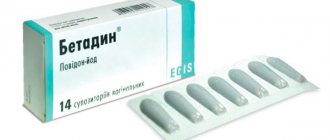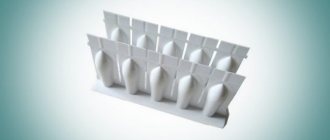Every woman has vaginal discharge. They can be natural or occur as a result of a serious disorder in the body. In gynecology, the use of special vaginal suppositories for discharge is actively practiced. Suppositories for women's discharge are easy to use and have an effective local effect.
Why do I have brown discharge after my period?
The work of the excretory system is always associated with internal processes. The causes of brown spotting after menstruation can be both physiological and pathological. In the first case, the change in color of the discharge is due to the oxidation of menstrual blood under the influence of oxygen. Because of this, the discharge takes on a brown tint. If the symptom is accompanied by an unpleasant odor, itching and pain in the abdomen, the cause of the discharge may be pathological. Factors that provoke the appearance of brown spotting include:
- endometriosis;
- ectopic pregnancy;
- damage to the vaginal mucosa;
- the presence of polyps in the uterus;
- infectious diseases;
- uterine hyperplasia;
- myoma;
- inclination of the cervix.
Brown discharge after period for several days
Doctors do not always consider brown discharge at the end of menstruation a deviation. If they only last a few days and do not cause discomfort, there is no need to worry. Typically, such discharge indicates the end of the critical days. A small amount of blood may stagnate in the pelvis due to a pathology in the structure of the uterus, for example, when it is bent. The blood has time to clot. For this reason, it is distinguished by a dark shade.
Even more interesting:
Brown discharge 5 days after period
The appearance of blood 4-5 days after the end of menstruation is a serious reason to consult a doctor. Such discharge is not associated with menstruation. The deviation may be accompanied by the following symptoms:
- unpleasant odor;
- abdominal pain;
- increase in body temperature;
- the presence of clots;
- burning and itching in the vagina.
Under certain circumstances, brown discharge occurs as a result of a ruptured follicle. If blood appears 5 days after menstruation, we are talking about early ovulation. Due to rupture of the follicle walls, blood vessels are damaged. This results in the release of a few drops of blood. At the moment the ovulatory fluid leaks into the abdominal cavity, the woman notices pain in the abdomen.
Spotting after menstruation for a week
Spotting after menstruation, lasting for a week, most often appears with endometriosis. The disease is accompanied by pathological growth of the endometrium outside the uterus - on the rectum, fallopian tubes and bladder. The reasons for its appearance include:
- surgical intervention;
- disruption of hormone production;
- formation of a focus of inflammation in the pelvic organs;
- hereditary predisposition.
Spotting a week after menstruation
The formation of a pathological process may be indicated by dark discharge after menstruation, which appears a week later, which indicates the formation of a pathological process. They can occur due to a lack of hormones or as a result of an inflammatory process. Such discharge is not the norm. To identify the cause of their formation, a gynecological examination is performed. To combat inflammation, women are prescribed antibiotics, and in case of hormonal imbalance, oral contraceptives are prescribed.
Brown discharge 10 days after period
Brown discharge after menstruation appears after 10 days
To determine the cause of their appearance, it is advisable for a woman to pay attention to the following parameters:
- volume of discharge;
- smell;
- color;
- accompanying symptoms.
Brown clots after menstruation are a sign of an inflammatory process or a bend of the uterus. In this case, menstrual blood cannot come out completely during menstruation. It curls up and darkens, and then is released throughout the cycle. If blood appears after sexual intercourse, the cause is erosion or other formations on the walls of the vagina.
Brown discharge after period after 2 weeks
If the woman is completely healthy, they may indicate attachment of the embryo to the uterine cavity. This phenomenon is called implantation bleeding. It usually appears 7-12 days after ovulation. Implantation does not pose any danger to a future pregnancy.
Suppositories in gynecology
For uncharacteristic vaginal discharge, doctors often resort to prescribing suppositories. This is due to the fact that drugs in this group have a local effect and help directly eliminate the foci of inflammation themselves. These remedies prove to be effective in the fight against various infections that cause secretions with an unpleasant odor.
Rectal
When an unpleasant odor emanates from secreted secretions, doctors often prescribe rectal suppositories, which are inserted into the anus. The difference between these drugs is that after placing the drug in the rectum, it dissolves and penetrates into the lesion, rather than leaking out.
For the treatment of adnexitis, the following drugs are used:
- Diklak;
- Diclofenac;
- Voltaren;
- Ortofen.
These are non-steroidal anti-inflammatory drugs that can eliminate inflammation, reduce temperature and suppress pain.
When candidiasis is detected, the following medications are prescribed:
- Ketoconazole;
- Itraconazole;
- Nystatin.
When infection penetrates into the vaginal mucosa, they often resort to the use of ichthyol suppositories. They have anti-inflammatory, analgesic and antiseptic effects. With their help, swelling is relieved and pain is relieved.
In order for the therapy to be effective and short-lived, rectal suppositories are recommended to be used in combination with vaginal suppositories.
Vaginal
The most popular among all suppositories are vaginal ones. They are easy to use and effective in combating various diseases. The products have a spherical shape with a rounded end. Due to this, there are no difficulties in the process of inserting them into the vagina.
Among the most common vaginal products are the following:
- Clindacin. The drug is used in the treatment of gardnerellosis and when the body is affected by various infections (streptococcal, staphylococcal, mycoplasma and clostridial). The product is ineffective in the fight against fungal infections and trichomoniasis.
- Gynoflor. The medication restores the vaginal microflora. It is prescribed after antimicrobial therapy or when the secretion acquires a yellow tint.
- Fluomizin. The drug has an antiseptic effect and has a detrimental effect on trichomonas, gram-negative microorganisms, cocci and fungal infections. It is used in the treatment of vulvovaginitis and colpitis.
- Klion-D. It has antiprotozoal, antimicrobial and antifungal properties. With its help, itching and unpleasant odor are eliminated. The drug can affect the composition of microflora and the acidity of the environment. Prescribed for trichomoniasis.
- Terzhinan. Antimicrobial and antifungal medication that suppresses anaerobic microflora.
- Isoconazole Eliminates dermatophytes and has a detrimental effect on yeast-like and mold fungi.
- Lomexin. Used in the treatment of candidiasis.
- Iodoxide. It is used in the fight against bacterial vaginosis and has a complex effect on the pathological process.
Uterine
If green discharge appears during certain periods of the menstrual cycle or after sexual intercourse, doctors may resort to prescribing uterine suppositories, which are inserted into the cervix.
Causes of bleeding during menopause
Menopause occurs when a woman is 50 years old. Clinically, it is expressed in the form of cessation of the menstrual cycle, the cause of which was age-related ovarian dysfunction.
Menopause does not occur instantly. For 9 to 12 months, a woman experiences premenopause - a restructuring of the body, which is characterized by:
- irregular cycle,
- spotting instead of regular discharge.
The appearance of spotting is associated with the gradual cessation of ovarian function. During premenopause, their presence is not dangerous.
Menopause is characterized by a long absence of critical days (about 12 months). Spotting and spotting that appears 1 year after the last menstruation may indicate the presence of a serious gynecological pathology or disease.
What can cause discharge during menopause?
Determining the cause of discharge
Age-related changes in vaginal microflora
With the onset of menopause, the ovaries stop producing estrogen-type sex hormones:
This leads to a change in the qualitative composition of the cervical mucus and thinning of the epithelium - the mucous membrane lining the vagina. Any mechanical injuries and minor damage can lead to bleeding. Usually their secretion increases after sexual intercourse.
Inflammatory processes of the genital tract
The most common types of inflammation are:
- vaginitis - inflammation of the vagina;
- cervicitis - inflammation of the cervix;
- candidiasis - thrush.
If a woman who has reached menopause continues to be sexually active, infections and STDs can become the cause of the inflammatory process.
Bloody discharge is caused by the following types of bacteria:
- gonococci,
- trichomonas vaginalis,
- chlamydia.
Cervical polyps
The formation of a polyp leads to the proliferation of the epithelial membrane. Its tissues are easily damaged, which also leads to discharge.
According to medical research, the presence of spotting during menopause is associated with disturbances in carbohydrate and fat metabolism. The appearance of secretion can be caused by the following pathologies:
- diabetes mellitus,
- obesity,
- arterial hypertension - persistent high blood pressure.
Causes of discharge that appears due to removal of the ovaries
Women of reproductive age who have undergone surgery to remove the ovaries. susceptible to menopause syndrome. In patients, the secretion of female hormones decreases, which leads to inevitable restructuring of the body and changes in the mucous membrane:
- the epithelial layer becomes thinner,
- vaginal dryness is noted.
Minimal trauma and microcracks usually lead to brown bloody discharge.
How to determine the cause of the pathology?
In order to determine the cause of vaginal bleeding, the gynecologist uses complex research methods. Typically they include:
- palpation of the uterus,
- examination of the pelvic organs using ultrasound,
- tissue biopsy - collection of biological material for clinical research for the presence of degenerative changes,
- bacteriological culture,
- other laboratory methods for studying vaginal microflora.
The menopause period is considered the most dangerous period for a woman. Due to the cessation of hormone secretion by the ovaries, the mucous membrane ceases to perform barrier functions - the function of protecting the body from microbial pathogens of gynecological pathologies. If bloody discharge occurs, the patient should immediately consult an experienced doctor to eliminate the risk of cancer.
Classification and mechanism of action
During the inflammatory process, gynecologists recommend using vaginal suppositories. They quickly penetrate the lesion, eliminate unpleasant symptoms and discomfort. The following types of candles for women can be distinguished:
- vaginal,
- rectal (introduced into the rectal area),
- stick-shaped suppositories with a rounded end (designed for the cervix and urethra).
For each disease, a separate treatment is selected. The doctor must take into account the characteristics of the disease, characteristic signs and clinical manifestations. Absolutely all candles are similar to each other in their mechanism of action. They include an active substance, a fat base. It contains gelatin, paraffin, glycerin. At room temperature they are solid.
When the candle enters the body, the material begins to melt. The substances included in the composition are released and begin to act. Some of them have a local effect, improve the condition of the mucous membrane, and eliminate inflammatory processes.
In the superficial tissue of the vagina, as well as the rectum, there are a huge number of small blood vessels. A separate part of the active components penetrates into the bloodstream. As a result, lymph circulation occurs in the pelvic area. The patient begins to feel relief. The active components are quickly absorbed into the blood, so the substances do not penetrate the kidneys, liver and other internal organs.
The main advantage of suppositories, unlike other medications that are taken orally, is the absence of an allergic reaction. Tablets and suspensions can cause irritation of the gastrointestinal mucosa. Gynecological suppositories have different types of action. They have the following effect and mechanism of action:
- elimination of infection,
- anti-inflammatory effect,
- restoration of soft tissues,
- normalization of the balance of vaginal microflora,
- analgesic effect.
Vaginal suppositories do not have a wide spectrum of action, but now pharmaceutical companies are producing drugs that can relieve the inflammatory process and have an effect on pathogens. Some anti-inflammatory suppositories contain vitamins that promote the proper functioning of soft tissues. Such substances stimulate the immune system.
The composition may contain synthetic and natural components. The main infectious agents that cause gynecological diseases are viruses, bacteria, protozoa and fungi.
Related and recommended questions
Positive test, brown discharge I am worried about nagging pain in the abdomen and lower back,…
Scanty dark brown discharge instead of menstruation. March had unprotected sex, which...
Red-brown discharge after a delay. I take duphaston. Last menstruation...
Two weeks late, spotting, positive test I had sexual intercourse...
Delay 20 days, brown discharge, test negative I’m 18 years old) I’m from a very...
Delay, positive test, brown discharge December 22, 2015 should have started...
Lack of menstruation, chest hurts, positive test I wanted to know my last menstruation...
Brown discharge, delay Elena Viktorovna, after a summer holiday and intensive...
Positive test, blood and brown discharge. I already wrote to you, but I have again...
Delay, test weakly positive I had my last period on September 21, I’m checking...
Brown discharge instead of menstruation. My period was delayed by 7 days. Then they started...
Breast hurts, delay 20 days Please tell me! The last menstruation was on April 25!…
Discharge is brown, delayed for 5 days. Please help. I'm 5 days late...
Positive test, ultrasound doesn’t show Last menstrual period was from July 7 to 07/11/13 9…
Delayed menstruation brown discharge I started having sex on June 10th of this year...
Positive test before the delay Before the delay is 1 day, tests for 7 days in a row show...
Brown discharge with a positive test I have a question, we are planning...
The test is positive in the absence of pregnancy. My question is this. November 8th was...
Delay, ultrasound negative, 2 stripes, one weak, hCG test My last period was...
Pregnancy test, the second line is barely visible. Please tell me I have a test for...
Normal discharge
Vaginal discharge in a woman of any age is an indicator of the state of reproductive health. The decline of the body's reproductive function is reflected in the production of mucus in the cervix. It continues to fulfill its protective role, preventing infectious agents from entering the organs. However, its volume decreases to the point that during this period women experience vaginal dryness.
It is believed that during menopause, mucous discharge is normal if its volume does not exceed 2 ml per day, it is transparent (may have a slight yellowish tint due to oxidation of mucus in the air). In addition, they should not have a strong odor. The discharge contains not only mucus, but also plasma and lymph, so its consistency resembles rice water.
Normal leucorrhoea during menopause does not cause discomfort or irritation of the genitals in a woman.
How to use it correctly
To use suppositories correctly, you must strictly follow the instructions for use. But there are generally accepted rules of use. Anti-inflammatory vaginal suppositories are recommended to be placed in the evening before going to bed. Before starting the procedure, it is important to take a shower and wash yourself.
If a woman experiences heavy discharge, the effect of using suppositories may be reduced. When a doctor prescribes rectal suppositories for heavy discharge, the intestines are first emptied. Some patients resort to using an enema. Before the procedure, it is important to thoroughly wash and disinfect your hands with an antiseptic. The suppositories are administered in a supine position.
Suppositories are completely inserted into the vagina or rectal cavity. You need to lie down for 10 minutes for the candle to begin to dissolve. Some manufacturers recommend moistening them with water so that the active components are released faster. Do not use sanitary pads or tampons at the same time. They become an obstacle to the release of bacteria and secretions. Treatment of discharge in women is a labor-intensive process. You must follow all recommendations and prescriptions of your doctor.
Brown discharge - description and causes
The discharge that women may encounter during menopause can be of different types. They differ in color and consistency. Many people call brown discharge “spotting” and it is most often not too abundant
If brown discharge comes in clots or in large quantities, then this is an alarming signal and it is important to immediately contact a specialist. In addition to brown and light brown discharge, they may contain various inclusions, which in the future the doctor will be able to diagnose the disease that provoked them.
For a more thorough examination of vaginal discharge during menopause, you can use a hygienic tampon. It is placed in the vagina and taken out after a few hours, after which the nature of the discharge, as well as its abundance, is studied.
There are several reasons that provoke the appearance of brown discharge during menopause.
Also read why yellow discharge may appear during menopause.
Some of the most common ones include:
- mechanical type vaginal injuries. This is due to the fact that with the onset of menopause, the vagina loses moisture and its walls become dry and, accordingly, susceptible to various injuries. The integrity of the vaginal walls can be damaged during intimacy or during an examination by a gynecologist. If the cause of brown discharge is a mechanical injury, then there is no need to resort to any special treatment. You only need to use moisturizing ointment or suppositories that contain estrogens as a preventive measure;
- diseases of the cervix. This disease can be identified by brown discharge during menopause, which contains blood clots, and the discharge is abundant. The last sign indicates that there is a risk of developing uterine cancer. Considering that pathology often does not manifest itself in any way during its development, it can be diagnosed only at the last stages of development. This is an obstacle to treatment and recovery from the disease. There are cases when bloody or brown discharge, appearing due to cervical cancer, begins some time after intimacy, they are also accompanied by pain that radiates to the lumbar spine;
- uterine fibroids. The disease is a benign tumor in the uterus. Symptoms for this disease are brown or bloody discharge during the menopausal period. The discharge is characterized by abundance. If you do not treat the pathology and allow it to reach large sizes, then this can be identified by symptoms in the form of pain in the lumbar spine, in the sacrum and perineum;
- growth of the uterus. The reason, which is one of the most common, provokes the appearance of brown discharge during menopause. There is an increase in the amount of skin epithelium inside the uterus. Often, brown discharge with this disease becomes blood-red in color, and its character is variable: from abundant to scanty. In the future, there is a risk of anemia;
- ovarian tumor. A disease that manifests itself in a very strange, atypical way and women often do not pay attention to them, or rather, do not suspect that such symptoms may indicate an illness. When pathology appears, the skin, hair and nails improve, the woman’s appearance becomes more attractive and youthful. At the same time, there is a brown discharge from the vagina, reminiscent of blood during menstruation. Most often, women assume that such symptoms indicate a temporary cessation of menopause, however, this is a very alarming sign that requires immediate examination by a specialist;
- polyps in the uterine area. Pathology occurs quite often during the menopausal period. In addition to direct growths of the uterine area (polyps), the disease is accompanied by the appearance of some kind of infectious process. The discharge is brown in color and spotty in nature.
Diseases and names of suppositories
There are several main gynecological diseases for which patients are prescribed the use of rectal suppositories. They can act as the main therapeutic treatment or serve as an adjunct:
The duration of treatment is calculated individually. The doctor will definitely take into account the indications for use, the severity of the disease, as well as the characteristic symptoms and signs of pathology.
Prevention
An important step during the menopausal period is prevention. Following simple rules will help you avoid the unpleasant consequences of menopause.
Hygiene rules
Women are strongly advised to maintain intimate hygiene, especially in the presence of pathological discharge. When using pads, they should be changed at least five times a day. When performing hygiene procedures, it is best to use baby soaps and gels that do not contain any fragrances.
Lifestyle
It is possible to cope with anxiety symptoms during menopause through lifestyle modifications. Women who have reached the age of fifty are advised to eat right, spend more time in the fresh air, and engage in amateur sports. The best option would be swimming, cycling, running or brisk walking. You can also do exercises in the morning.
The right attitude towards the problem and a positive attitude will do the trick.
Nutrition
During menopause, special attention should be paid to nutrition. To strengthen bones, it is recommended to include dairy and fermented milk products in the daily menu, including low-fat cottage cheese
You should reduce your consumption of fatty, spicy, fried foods, smoked foods, coffee and alcohol. The main emphasis in nutrition should be on eating cereals, fresh vegetables, fruits and herbs.
Popular vaginal suppositories for odor and itching
Vaginal suppositories for women can be prescribed by a doctor for various reasons. One of them is an infection in the vagina, a clear symptom of which is an unpleasant odor and discomfort in the form of itching and burning. An unpleasant odor from the vagina can be explained very simply. Pathogenic microorganisms emit specific gases, and these give rise to unpleasant odors. Vaginal odor is normal - it is a weak or slightly specific odor, but is not accompanied by other unpleasant symptoms.
If there is an infection in a woman’s genital tract, the smell takes on a putrid, sourish tint. At the same time, it is combined with burning and itching in the external genitalia and vagina. However, it is precisely by the change in smell that a woman herself may suspect that she has a problem, which is always a reason for an urgent visit to the antenatal clinic.
Common causes of vaginal discomfort
The presence of unpleasant odors emanating from the vagina is a rather alarming bell. However, smell alone does not always directly indicate inflammation. It may be a symptom of a disorder of the glandular apparatus or associated with metabolic disorders. But when it is accompanied by itching and burning, then the woman will most likely be diagnosed with an inflammatory process.
Types of gynecological diseases.
Factors that lead to the appearance of an unpleasant odor from the vaginal cavity are:
- Vaginal dysbiosis is a condition that characterizes shifts in the ratio between normal and pathogenic microorganisms in the vaginal microflora. This condition may be caused by a deterioration in the protective mechanism of the mucous membranes, which creates a favorable environment for the functioning of pathogenic bacteria.
- Candidiasis (thrush, infections by fungi of the genus Candida). With this pathology, a curd-like white discharge with a sour, unpleasant odor is noted.
- Colpitis is an inflammatory process that spreads to the mucous membranes of the vaginal walls and the outer part of the genital organs. Colpitis can be caused by activation of coccal flora or diseases transmitted through sexual contact.
- Gardnerellosis - this disease is caused by the pathogen Gardnerella, its course is accompanied by an odor very similar to that coming from rotten fish.
- Inflammatory processes occur chronically in the uterus and appendages in a sluggish form and are characterized by a small amount of discharge.
- Clindacin. This bacteriostatic medicine is indicated for the treatment of gardnerellosis. In addition, it is prescribed for streptococcal, staphylococcal, mycoplasma and clostridium infections. However, there is no effect when prescribing the drug for the treatment of fungal infections and trichomoniasis. 1 suppository is inserted into the vagina at night. within 3-7 days (as prescribed by the doctor). Pregnant women are not prescribed medications during the first trimester.
- Gynoflor. Gynoflor vaginal suppositories are designed to restore healthy flora in the vagina. As a rule, they are prescribed after a series of measures have been taken for antimicrobial treatment with systemic or local drugs. The use of 2 suppositories per day is indicated. Duration of treatment is 1-2 weeks. The medicine is contraindicated in cases of estrogen-dependent formations and endometriosis.
- Fluomizin. Belongs to a group of drugs with an antiseptic effect. Can have a detrimental effect on cocci, gram-negative microorganisms (Escherichia coli, Gardnerella, Klebsiella, protozoa, etc.), Trichomonas, fungal pathogens. Vaginal suppositories are indicated for vulvovaginitis and colpitis, 1 piece per night for a course of up to 5-6 days. The procedures are stopped for the period of menstruation. The medicine is allowed to be used by pregnant women. The effect of the drug on the body of a nursing woman has not been studied. Therefore, when breastfeeding, it is advisable to stop using the product.
- Klion-D is a drug with antifungal, antiprotozoal, antimicrobial action, in which the active substance is metronidazole. Very quickly eliminates unpleasant symptoms (itching and unpleasant odor). But it cannot affect the acidity of the environment and the composition of the vaginal flora. Prescribed mainly for the treatment of trichomoniasis.
- Terzhinan is considered an antifungal and antimicrobial drug that suppresses anaerobic microflora (including pathogens - gardnerella and trichomonas). It contains neomycin (an antibiotic substance), ternidazole (an antimicrobial agent), nystatin (an antifungal substance), prednisolone (a corticosteroid substance that helps relieve the inflammatory response). The product is used once every day, the course is up to 10-20 days.
- Isoconazole These vaginal suppositories are prescribed to eliminate dermatophytes, molds and yeast-like fungi, some gram-positive microorganisms and corynebacteria. The medicine is administered into the vagina before bedtime once a day, the course is 1-3 days.
- Lomexin is a drug that is used to combat thrush and contains fenticonazole. A vaginal capsule (600 mg) is inserted into the vagina every day for 3 days. A 1000 mg capsule is enough for 2 days of treatment. Medicines are not used during menstruation and pregnancy.
- Iodoxide. This drug is designed for a complex effect on bacterial vaginosis. Not prohibited during menstruation. Suppositories are administered twice a day for 1-2 weeks. Contraindications for using the product are thyroid adenoma, pregnancy, hyperthyroidism.
These are the main causes of unpleasant vaginal odor. However, it can often be triggered by a banal failure to comply with personal hygiene rules. In any case, it is best to trust a gynecologist to identify the cause of the discomfort that comes out of the groin area.
Return to the topic Therapeutic measures for discomfort in the vagina
Treating unpleasant symptoms on your own without knowing the nature of their occurrence is very dangerous for women’s health. Only a doctor, after a thorough diagnosis and identification of the source of negative symptoms, can prescribe adequate treatment to the patient. Therefore, a timely visit to a gynecologist is the key to quickly getting rid of annoying symptoms.
Typically, treatment measures are limited to local exposure using special medications. Trichopolum, Metronidazole, Metrogyl, produced in the form of suppositories or tablets, give a good effect in this regard.
Often the use of antimicrobial agents is supplemented with other local drugs: hydrogen peroxide, Tomicide, etc. Solutions of these substances are used for vaginal irrigation and douching.
Unlike oral tablet drugs, local medications do not have a systemic effect on the body, and therefore they have a minimum of side effects. While the former can cause headaches, dyspeptic disorders, and blood pressure disorders.
Advanced situations of vaginal dysbiosis with the presence of complications can be accompanied not only by a disgusting fetid odor, but also by obvious signs of inflammation. Therefore, it is no longer possible to do without antibiotics. Clindamycin, Cephalosporin, Oleandomycin are indicated.
To monitor the success of the therapy used, it is recommended to do a follow-up test (laboratory tests) a week after the start of treatment. And then compare the results before and after taking the medications. Such tests are taken repeatedly to ensure the quality of the healing effect and the correctness of the approach to treatment.
During treatment you should abstain from intimacy or use condoms. This will allow the vaginal flora to recover faster and prevent possible relapses of the disease.
When carrying out drug treatment, you should simultaneously make some efforts to normalize the body's protective functions. Therefore, you should immediately stop following steep diets, and it is better to think over a nutritious nutrition system. You should eat more berries and fruits. They should replace baked goods and sweets. It is also important to drink enough water (still), eliminate bad habits (alcohol and tobacco abuse).
It would be good to remember the rules of intimate hygiene: take a shower daily, perform thorough toileting of the external genital organs, promptly change underwear and personal hygiene products.
Return to zmist Popular candles for itching and odor
In accordance with the identified cause that led to the development of the foul odor, the doctor prescribes vaginal suppositories for the odor. Such suppositories can normalize the composition of the vaginal microflora and stop the growth of pathogenic bacteria.
Today, the pharmaceutical industry offers a wide range of vaginal medications. Which suppositories are the most effective for itching and odor? The doctor will say this after he has the results of the smears in his hands. Under no circumstances should you try to treat vaginal dysbiosis on your own, as this can only worsen the course of the disease and lead to its resistance.
Return to zmistRealik of the most popular vaginal suppositories
Below are the popular drugs:
Vaginal suppositories for itching and odor are a very convenient therapeutic tool in the fight against infectious and inflammatory pathologies in the vaginal environment.
Main causes of pathology
There are a number of reasons that can cause pathological vaginal discharge. In particular, these may be:
- The reasons are hormonal. During menopause, serious changes occur in hormonal levels. The amount of estrogen synthesized by the ovaries decreases as menopausal changes progress, often provoking pathological processes. For example, hyperplasia, which causes the growth of the uterine endometrium;
- The causes are infectious. Very often during menopause there is a decrease in local immunity, which provokes the development of inflammatory processes caused by opportunistic microflora. Sometimes the cause of suspicious discharge is sexually transmitted infections;
- Causes caused by metabolic disorders. Malfunctions in the activity of the endocrine system and the functioning of the thyroid gland can provoke the development of pathological processes in the organs of the reproductive system, and, as a result, a change in the nature of the discharge.
Types of pathological discharge
Depending on the nature of the pathology, the following types of discharge may appear:
- mucous membranes (if they are too scanty or too abundant, have the consistency of foam, or smell bad);
- purulent (thick, have a grayish-green tint, pungent odor);
- curdled (white, with lumps, have a sour smell);
- bloody (color from bright red to brown, appearing in the form of ichor, spotting or bleeding).
Bloody discharge is considered the most dangerous, especially in the postmenopausal period. when they cannot be confused with menstruation.
Bloody discharge during perimenopause
Until about 45-50 years of age, a woman still begins to menstruate, but the regularity of their arrival is disrupted due to the instability of hormonal processes in the body. The volume and duration of bleeding varies. They can be spotty brown for less than 2 days, and the next time they become profuse burgundy-red and continue without stopping for 2 weeks. In addition to irregular periods, menopause may cause bleeding if a woman takes hormone replacement therapy to relieve hot flashes and other ailments of this period.
During premenopause, women are more likely to develop endocrine diseases that increase hormonal shifts. Improper metabolism, which occurs due to poor functioning of the digestive organs and lack of vitamins, leads to disruption of hormone production. All this causes irregular bleeding.
The origin of bleeding during postmenopause
With the cessation of menstruation and hormonal changes in a woman, physiological factors that could lead to the appearance of spotting disappear. Now they become only a symptom of pathology (diseases of the uterus or appendages).
Warning: If traces of blood appear in the discharge of postmenopausal women, delaying a visit to the doctor is especially risky. The most serious cause of such discharge may be uterine cancer. By postponing a visit to the gynecologist, trying to somehow eliminate the problem on her own, a woman loses precious time for timely detection and removal of the tumor.
Neoplasms
With the onset of menopause, the risk of neoplasms in the female reproductive system increases. And all kinds of tumors that are in remission can worsen and begin to progress against the background of hormonal changes. Let's consider the features of dangerous diseases during menopause in women.
Cystoma
The cyst itself is a benign tumor that is localized on one or two uterine appendages. With the onset of hormonal changes in a woman’s body associated with menopause, the cystoma can go into a borderline state, the development of which can result in adnexal cancer. Therefore, it is necessary to constantly monitor the condition of the cystoma.
As the cystoma develops, it increases in size and begins to manifest itself with the following symptomatic factors:
- pain, aching in nature, radiating to the groin area or the sacrum area;
- bursting sensations in the peritoneum;
- frequent urination;
- stool disorders accompanied by constipation or the development of diarrhea.
If the tumor stalk accidentally twists, this can cause severe pain, an attack of rapid heartbeat, vomiting and a sharp increase in temperature.
Cystoma should be treated only with surgical methods, the nature of which directly depends on the stage of development of the pathology.
Myoma
Typically, uterine fibroids can occur before menopause. When menopause begins, the pathology begins to enter a regressive stage. After all, for the development of this pathology, a normal level of estrogen is necessary, of which there are very few in this life period of the female body. Due to the low estrogen content, the process of reducing the size of the uterus itself begins, which leads to shrinkage and further disappearance of fibroids.
But there are cases when the uterus does not decrease in size during menopause, and fibroids begin to contribute to the manifestation of the following symptoms:
- uncharacteristic bleeding from the vagina;
- decreased hemoglobin levels;
- increase in the endometrial layer;
- an increase in the size of the ovaries, which can cause the development of neoplasms on these organs.
If the fibroid arose before the onset of menopause and has a non-regressive nature, then the menopause will occur later than with a regressing tumor or its absence. Such a tumor does not decrease in size even with the onset of menopause, but only continues to grow. If the tumor is predisposed to spontaneous resorption, then its decrease in size is observed a couple of years before the onset of premenopause.
To ensure that the menopause does not cause health problems, it is necessary to listen carefully to all the symptoms that appear, and promptly eliminate all inflammation and other pathologies with the help of special medications designed to ensure a mild course of the menopause. Only in this case will the onset of a new period in a woman’s life be comfortable and not foretell despondency.
Interesting and educational video on the topic:
Antifungal suppositories
At home, without prior consultation and testing, it is recommended to use broad-spectrum antifungal suppositories. Their peculiarity is that they are active against most fungal organisms. They relieve pain, itching, burning and redness.
There are two types of suppositories - vaginal and rectal. In gynecology, both types are used, but more often vaginal ones, which solve a number of problems:
- help eliminate curdled discharge;
- restore natural odor;
- normalize microflora;
- relieve redness and inflammation;
- reduce itching.
All candles are used according to the same principle and have the same rules of application:
- you need to wash yourself (douche) and wash your hands well with soap or treat them with an antiseptic;
- lie on your back and pull your knees to your chin for ease of administration of the drug;
- Insert a suppository into the vagina and lie there for 15 minutes.
When dissolved, part of the suppository may come out, and in order not to stain the laundry, it is recommended to use a sanitary pad.
Suppositories Clotrimazole
An inexpensive drug based on the substance of the same name, clotrimazole, has a wide range of antifungal effects. Available in different dosage forms: ointment, gel, suppositories, vaginal tablets, oral tablets, solution for external use. In addition to the active component, the suppositories contain wax and propylene glycol, which, when administered with heat, dissolve and allow clotrimazole to act. Upon contact with fungal organisms, it destroys their cell membranes and stops growth and development.
Tip: can be used for hemorrhoids (not in the acute stage) and itching in the anus.
The course of treatment is 5-7 days, and if during this time the disease does not subside, you need to change the drug. With prolonged use, itching, redness, and irritation appear due to an allergic reaction to clotrimazole. Do not use with other antifungal suppositories.
Livarol suppositories
The main active ingredient in Livarol suppositories is ketoconazole. It is active against yeast, dermatophytes, streptococci and staphylococci. When dissolved, the active component inhibits the synthesis of fungal membranes and stops the development of pathogenic microflora. Can be used for the treatment and prevention of fungal and bacterial diseases. The drug can also be used to eliminate infection after unprotected sexual intercourse.
When used vaginally, it is not absorbed into the blood, so it can be used during pregnancy and breastfeeding. Apply once a day at night. Prescribed for bacterial and fungal diseases. Candles should not be used if there is an individual intolerance to the components of the composition and for children under 12 years of age.
Pimafucin suppositories
The active ingredient is natamycin. Additional - solid fat, adipic acid, polysorb, cetyl alcohol, sodium bicarbonate. Available in the form of tablets, suppositories, ointments. Medicines are antifungal drugs that have a fungicidal effect. Natamycin, upon contact with a fungal organism, destroys their integrity and leads to death. The drug has local effects and is not absorbed into the blood. Suppositories are prescribed for candidiasis, vulvitis, vaginitis, vulvovaginitis. They stop the growth of pathogenic microflora, thereby reducing pain and itching. The drug can be used in all trimesters of pregnancy and during breastfeeding.
Together with Grikov, the drug has an antiseptic and antimicrobial effect. Prescribed for the treatment of acute and chronic candidiasis and the prevention of other infectious diseases. To be effective, you also need to treat your partner. For prevention, use 1 suppository for 5 days. Do not use in children under 15 years of age. If a rash or irritation of the mucous membrane occurs, replace the drug with an analogue.
If you start using suppositories at the initial stage of the disease, symptoms may disappear after the first use. Under no circumstances should you stop treatment before completing the course, as this can lead to a relapse.
How to treat bleeding?
Treatment of a patient with bleeding during menopause depends on the cause of its occurrence and intensity. If blood is released without stopping and this leads to anemia, then a diagnostic curettage is performed, during which the doctor removes the excess layer of the endometrium, and part of the biomaterial is sent for research, during which the cause of the bleeding is determined. Usually, after curettage, women under 50 can be prescribed corpus luteum hormones, and older women can be prescribed androgens to suppress sexual function.
If the pelvic organs are not affected, then conservative treatment is carried out. The patient is prescribed medications that spasm blood vessels and reduce blood loss; in addition, medications that strengthen the walls of the capillaries may be prescribed.
Malignant formations in the uterus and appendages are a direct indication for surgical intervention. During menopause, doctors usually do not try to perform organ-preserving operations to prevent relapse of the disease. Most often, during menopause, the uterus or uterus along with the appendages will be removed.
Passing the threshold of forty years, every woman has to face the process of hormonal changes in the body, called menopause.
But it is not so.
If you approach this issue consistently, competently, and prepare for the onset of menopause in advance, then it will pass without such negative consequences.
The reasons for their occurrence, types of discharge, prevention and treatment methods - all these and many other questions will be discussed further in the article.
Menopause occurs during three phases, but is always accompanied by hormonal instability in the body, which during the first two phases, premenopause and perimenopause, can be expressed by the production of bloody discharge.
They can be either brown or burgundy in color and last from two days to two weeks. Although this is a sign of an internal disorder, it is not considered a dangerous symptom.
A dangerous manifestation of the internal pathological process is the occurrence of spotting and bloody discharge during postmenopause, since during this period the cycle stops, and such discharge is nothing more than bleeding caused by a malfunction of the pelvic organs.
Treatment of discharge consists of eliminating the root cause of its formation, so the first thing you need to do is get tested, undergo an ultrasound examination of the pelvic organs and thyroid gland, and based on the research results, the doctor prescribes therapy: hormonal therapy or antibiotics that relieve the inflammatory process.
The enzymes included in medicinal herbs not only relieve inflammation and fight infection, but also soften and eliminate the feeling of dryness and itching.
Discharges caused by metabolic disorders and severe hormonal imbalance, along with hormonal therapy, are treated by douching with an infusion of birch and beech leaves.
A positive result in the treatment of pathological discharge and the removal of inflammatory and infectious processes is given by medicinal baths using antiseptics (furacelin, dioxedine) and decoctions of medicinal herbs.
Brew 30 g of lovage roots with a mug of hot water, let it brew for 20 minutes and take a bath with the decoction for 15 minutes.
White cinquefoil has a good effect on the genitourinary and endocrine systems, and it is useful to both make baths with its decoction and take 1/3 cup of white cinquefoil decoction internally 15 minutes before meals for two weeks.
What's included
Vaginal suppositories contain antibacterial components. These are substances that completely destroy bacteria and help stop their further reproduction. Suppositories containing antibiotics relieve all symptoms and clinical manifestations.
The most common and effective drugs are Penicillin, Trixomazole, and Chlorhexidine. These are odor and discharge suppositories that begin to act within 15 minutes after administration. Preparations that contain iodine and macrolides have proven themselves well. Antibiotics have contraindications for use, so you should not self-medicate. Patients may experience an allergic reaction, suppression of the natural microflora in the vagina.
Often, to treat diseases associated with the vagina, women's suppositories are used for secretions with an anti-inflammatory mechanism of action. They contain non-steroidal components that eliminate the signs and clinical manifestations of the inflammatory process. This may be painful sensations, swelling.
Components such as diclofenac, ichthyol, and indomethacin are added to such suppositories. In some cases, strictly according to the doctor’s indications, medications with prednisolone may be prescribed. Pharmaceutical companies produce rectal and vaginal suppositories that have an anti-inflammatory effect and contain herbal ingredients.
They help cure many women's diseases. These can be chamomile extracts, belladonna, cocoa butter, eucalyptus, calendula, pine needles. Candles with sea buckthorn oil are in greatest demand. Such suppositories are allowed to be used in old age and childhood, during breastfeeding and pregnancy.











